第十六週作業
本人學號:201771010138
姓名:鄒豐蔚
《面向物件程式設計(java)》第十六周學習總結
1、實驗目的與要求
(1) 掌握執行緒概念;
(2) 掌握執行緒建立的兩種技術;
(3) 理解和掌握執行緒的優先順序屬性及排程方法;
(4) 掌握執行緒同步的概念及實現技術;
2、實驗內容和步驟
實驗1:測試程式並進行程式碼註釋。
測試程式1:
l 在elipse IDE中除錯執行ThreadTest,結合程式執行結果理解程式;
l 掌握執行緒概念;
l 掌握用Thread的擴充套件類實現執行緒的方法;
l 利用Runnable介面改造程式,掌握用
class Lefthand extends Thread { public void run() { for(int i=0;i<=5;i++) { System.out.println("You are Students!"); try{ sleep(500); } catch(InterruptedException e) { System.out.println("Lefthand error.");} } } }class Righthand extends Thread { public void run() { for(int i=0;i<=5;i++) { System.out.println("I am a Teacher!"); try{ sleep(300); } catch(InterruptedException e) { System.out.println("Righthand error.");} } } } publicclass ThreadTest { static Lefthand left; static Righthand right; public static void main(String[] args) { left=new Lefthand(); right=new Righthand(); left.start(); right.start(); } }
利用Runnable介面改造程式後:
class Lefthand implements Runnable { public void run() { for(int i=0;i<=5;i++) { System.out.println("You are Students!"); try{ Thread.sleep(500); } catch(InterruptedException e) { System.out.println("Lefthand error.");} } } } class Righthand implements Runnable { public void run() { for(int i=0;i<=5;i++) { System.out.println("I am a Teacher!"); try{ Thread.sleep(300); } catch(InterruptedException e) { System.out.println("Righthand error.");} } } } public class M { public static void main(String[] args) { Runnable r=new Lefthand(); Runnable r1=new Righthand(); Thread t=new Thread(r); Thread t1=new Thread(r1); t.start(); t1.start(); } }
得出結果: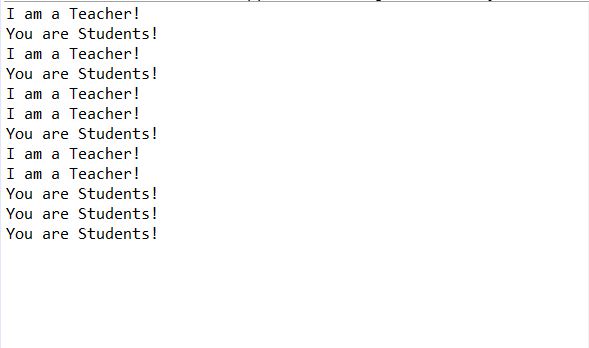
測試程式2:
l 在Elipse環境下除錯教材625頁程式14-1、14-2 、14-3,結合程式執行結果理解程式;
l 在Elipse環境下除錯教材631頁程式14-4,結合程式執行結果理解程式;
l 對比兩個程式,理解執行緒的概念和用途;
l 掌握執行緒建立的兩種技術。
14-1.14-2.14-3:
BallComponent:
package bounce; import java.awt.*; import java.util.*; import javax.swing.*; public class BallComponent extends JPanel { private static final int DEFAULT_WIDTH = 450; private static final int DEFAULT_HEIGHT = 350; private java.util.List<Ball> balls = new ArrayList<>(); /** 向元件中新增一個球。*/ public void add(Ball b) { balls.add(b); } public void paintComponent(Graphics g) { super.paintComponent(g); // 擦除背景 Graphics2D g2 = (Graphics2D) g; for (Ball b : balls) { g2.fill(b.getShape()); } } public Dimension getPreferredSize() { return new Dimension(DEFAULT_WIDTH, DEFAULT_HEIGHT); } }
BounceFrame:
package bounce; import java.awt.*; import java.awt.event.*; import javax.swing.*; public class Bounce { public static void main(String[] args) { EventQueue.invokeLater(() -> { JFrame frame = new BounceFrame(); frame.setDefaultCloseOperation(JFrame.EXIT_ON_CLOSE); frame.setVisible(true); }); } } /** 帶有球元件和按鈕的框架。*/ class BounceFrame extends JFrame { private BallComponent comp; public static final int STEPS = 1000; public static final int DELAY = 3; /** * 用顯示彈跳球和的元件構造框架 *啟動和關閉按鈕 **/ public BounceFrame() { setTitle("Bounce"); comp = new BallComponent(); add(comp, BorderLayout.CENTER); JPanel buttonPanel = new JPanel(); addButton(buttonPanel, "Start", event -> addBall()); addButton(buttonPanel, "Close", event -> System.exit(0)); add(buttonPanel, BorderLayout.SOUTH); pack(); } /** * 將按鈕新增到容器中 *按鈕標題 * 按鈕的動作監聽器 */ public void addButton(Container c, String title, ActionListener listener) { JButton button = new JButton(title); c.add(button); button.addActionListener(listener); } /** *向面板中新增一個彈跳球,使其彈跳1000次。 */ public void addBall() { try { Ball ball = new Ball(); comp.add(ball); for (int i = 1; i <= STEPS; i++) { ball.move(comp.getBounds()); comp.paint(comp.getGraphics()); Thread.sleep(DELAY); } } catch (InterruptedException e) { } } }
Ball:
package bounce; import java.awt.geom.*; /** * 從長方形邊緣上移動和彈跳的球 */ public class Ball { private static final int XSIZE = 15; private static final int YSIZE = 15; private double x = 0; private double y = 0; private double dx = 1; private double dy = 1; /** * 將球移動到下一個位置,如果球碰到其中一條邊,則反向移動 */ public void move(Rectangle2D bounds) { x += dx; y += dy; if (x < bounds.getMinX()) { x = bounds.getMinX(); dx = -dx; } if (x + XSIZE >= bounds.getMaxX()) { x = bounds.getMaxX() - XSIZE; dx = -dx; } if (y < bounds.getMinY()) { y = bounds.getMinY(); dy = -dy; } if (y + YSIZE >= bounds.getMaxY()) { y = bounds.getMaxY() - YSIZE; dy = -dy; } } /** * 獲取球在當前位置的形狀。 */ public Ellipse2D getShape() { return new Ellipse2D.Double(x, y, XSIZE, YSIZE); } }
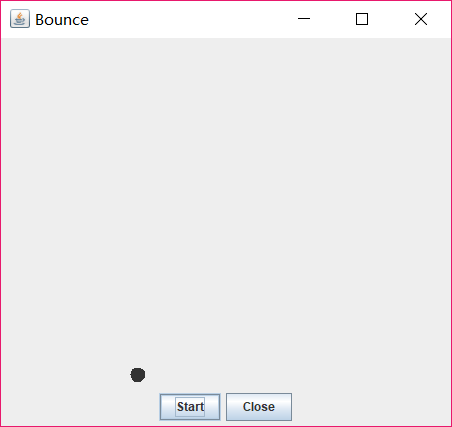
14-4:
BounceThread:
package bounceThread; import java.awt.*; import java.awt.event.*; import javax.swing.*; public class BounceThread { public static void main(String[] args) { EventQueue.invokeLater(() -> { JFrame frame = new BounceFrame(); frame.setTitle("BounceThread"); frame.setDefaultCloseOperation(JFrame.EXIT_ON_CLOSE); frame.setVisible(true); }); } } class BounceFrame extends JFrame { private BallComponent comp; public static final int STEPS = 1000; public static final int DELAY = 5; public BounceFrame() { comp = new BallComponent(); add(comp, BorderLayout.CENTER); JPanel buttonPanel = new JPanel(); addButton(buttonPanel, "Start", event -> addBall()); addButton(buttonPanel, "Close", event -> System.exit(0)); add(buttonPanel, BorderLayout.SOUTH); pack(); } public void addButton(Container c, String title, ActionListener listener) { JButton button = new JButton(title); c.add(button); button.addActionListener(listener); } public void addBall() /** 在畫布上新增一個彈跳球,並啟動一個執行緒使其執行*/ { Ball ball = new Ball(); comp.add(ball); Runnable r = () -> { try { for (int i = 1; i <= STEPS; i++) { ball.move(comp.getBounds()); comp.repaint(); Thread.sleep(DELAY); } } catch (InterruptedException e) { } }; Thread t = new Thread(r); t.start(); } }
得出結果:
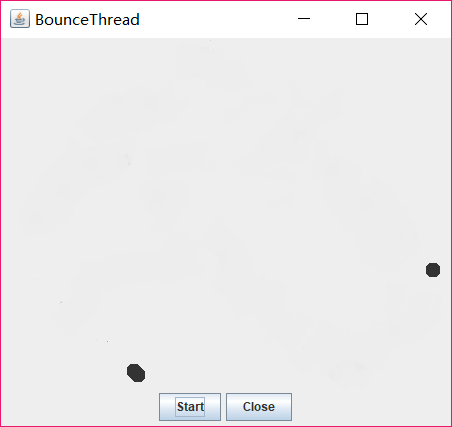
測試程式3:分析以下程式執行結果並理解程式。
class Race extends Thread { public static void main(String args[]) { Race[] runner=new Race[4]; for(int i=0;i<4;i++) runner[i]=new Race( ); for(int i=0;i<4;i++) runner[i].start( ); runner[1].setPriority(MIN_PRIORITY); runner[3].setPriority(MAX_PRIORITY);} public void run( ) { for(int i=0; i<1000000; i++); System.out.println(getName()+"執行緒的優先順序是"+getPriority()+"已計算完畢!"); } }

測試程式4
l 教材642頁程式模擬一個有若干賬戶的銀行,隨機地生成在這些賬戶之間轉移錢款的交易。每一個賬戶有一個執行緒。在每一筆交易中,會從執行緒所服務的賬戶中隨機轉移一定數目的錢款到另一個隨機賬戶。
l 在Elipse環境下除錯教材642頁程式14-5、14-6,結合程式執行結果理解程式;
UnsynchBankTest:
package unsynch; /** * 當多個執行緒訪問一個數據結構時,這個程式顯示資料損壞。 */ public class UnsynchBankTest { public static final int NACCOUNTS = 100; public static final double INITIAL_BALANCE = 1000; public static final double MAX_AMOUNT = 1000; public static final int DELAY = 10; public static void main(String[] args) { Bank bank = new Bank(NACCOUNTS, INITIAL_BALANCE); for (int i = 0; i < NACCOUNTS; i++) { int fromAccount = i; Runnable r = () -> { try { while (true) { int toAccount = (int) (bank.size() * Math.random()); double amount = MAX_AMOUNT * Math.random(); bank.transfer(fromAccount, toAccount, amount); Thread.sleep((int) (DELAY * Math.random())); } } catch (InterruptedException e) { } }; Thread t = new Thread(r); t.start(); } } }
Bank:
package unsynch; import java.util.*; public class Bank { private final double[] accounts; /** * @引數n表示賬戶數量 * @每個帳戶的初始餘額 */ public Bank(int n, double initialBalance) { accounts = new double[n]; Arrays.fill(accounts, initialBalance); } /** * 把錢從一個賬戶轉到另一個賬戶。 * @從帳戶中調出引數 * @向要轉賬的賬戶輸入引數 * @要轉帳的金額 */ public void transfer(int from, int to, double amount) { if (accounts[from] < amount) return; System.out.print(Thread.currentThread()); accounts[from] -= amount; System.out.printf(" %10.2f from %d to %d", amount, from, to); accounts[to] += amount; System.out.printf(" Total Balance: %10.2f%n", getTotalBalance()); } /** * 獲取所有帳戶餘額的總和。 * 返回總餘額 */ public double getTotalBalance() { double sum = 0; for (double a : accounts) sum += a; return sum; } /** *獲取銀行中的帳戶編號. * 返回賬號 */ public int size() { return accounts.length; } }
得出結果:

綜合程式設計練習
程式設計練習1
- 設計一個使用者資訊採集程式,要求如下:
(1) 使用者資訊輸入介面如下圖所示:
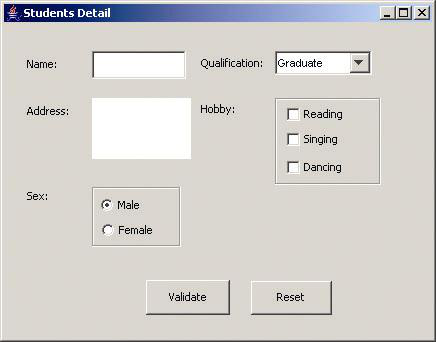
(2) 使用者點選提交按鈕時,使用者輸入資訊顯示控制檯介面;
(3) 使用者點選重置按鈕後,清空使用者已輸入資訊;
(4) 點選視窗關閉,程式退出。
Main:
import java.awt.EventQueue; import javax.swing.JFrame; public class Mian { public static void main(String[] args) { EventQueue.invokeLater(() -> { demo page = new demo(); }); } }
WinCenter:
import java.awt.Dimension; import java.awt.Toolkit; import java.awt.Window; public class WinCenter { public static void center(Window win){ Toolkit tkit = Toolkit.getDefaultToolkit(); Dimension sSize = tkit.getScreenSize(); Dimension wSize = win.getSize(); if(wSize.height > sSize.height){ wSize.height = sSize.height; } if(wSize.width > sSize.width) { wSize.width = sSize.width; } win.setLocation((sSize.width - wSize.width)/ 2, (sSize.height - wSize.height)/ 2); } }
Demo:
import java.awt.*; import java.awt.event.*; import javax.swing.*; import javax.swing.border.*; public class demo extends JFrame { public demo() { JPanel panel1 = new JPanel(); panel1.setPreferredSize(new Dimension(700, 45)); panel1.setLayout(new GridLayout(1, 4)); JLabel label1 = new JLabel("Name:"); JTextField j1 = new JTextField(""); JLabel label2 = new JLabel("Qualification:"); JComboBox<Object> j2 = new JComboBox<>(); j2.addItem("Graduate"); j2.addItem("Not Graduate"); panel1.add(label1); panel1.add(j1); panel1.add(label2); panel1.add(j2); JPanel panel2 = new JPanel(); panel2.setPreferredSize(new Dimension(700, 50)); panel2.setLayout(new GridLayout(1, 4)); JLabel label3 = new JLabel("Address:"); JTextArea j3 = new JTextArea(); JLabel label4 = new JLabel("Hobby:"); JPanel p = new JPanel(); p.setLayout(new GridLayout(3, 1)); p.setBorder(BorderFactory.createLineBorder(null)); JCheckBox c1 = new JCheckBox("Reading"); JCheckBox c2 = new JCheckBox("Singing"); JCheckBox c3 = new JCheckBox("Dancing"); p.add(c1); p.add(c2); p.add(c3); panel2.add(label3); panel2.add(j3); panel2.add(label4); panel2.add(p); JPanel panel3 = new JPanel(); panel3.setPreferredSize(new Dimension(700, 150)); FlowLayout flowLayout1 = new FlowLayout(FlowLayout.LEFT, 20, 40); panel3.setLayout(flowLayout1); JLabel label5 = new JLabel("Sex:"); JPanel p1 = new JPanel(); p1.setLayout(new GridLayout(2,1)); p1.setBorder(BorderFactory.createLineBorder(null)); ButtonGroup bu = new ButtonGroup(); JRadioButton jr1 = new JRadioButton("Male"); JRadioButton jr2 = new JRadioButton("Female"); bu.add(jr1); bu.add(jr2); p1.add(jr1); p1.add(jr2); panel3.add(label5); panel3.add(p1); add(panel1); add(panel2); add(panel3); JPanel panel4 = new JPanel(); panel4.setPreferredSize(new Dimension(700, 150)); JButton b1 = new JButton("Validate"); panel4.add(b1); JButton b2 = new JButton("Reset"); panel4.add(b2); add(panel4); FlowLayout flowLayout = new FlowLayout(); this.setLayout(flowLayout); this.setTitle("Students Detail"); this.setBounds(200, 200, 800, 400); this.setVisible(true); this.setDefaultCloseOperation(DISPOSE_ON_CLOSE); b1.addActionListener(new ActionListener() { public void actionPerformed(ActionEvent e) { // TODO 自動生成的方法存根 String xueli = j2.getSelectedItem().toString(); System.out.println("Name:" + j1.getText()); System.out.println("Qualification:" + xueli); String hobbystring = "Hobby:"; if (c1.isSelected()) { hobbystring += "Reading"; } if (c2.isSelected()) { hobbystring += "Singing"; } if (c3.isSelected()) { hobbystring += "Dancing"; } System.out.println("Address:" + j3.getText()); if (jr1.isSelected()) { System.out.println("Sex:Male"); } if (jr2.isSelected()) { System.out.println("Sex:Female"); } System.out.println(hobbystring); } }); b2.addActionListener(new ActionListener() { public void actionPerformed(ActionEvent e) { // TODO 自動生成的方法存根 j1.setText(null); j3.setText(null); j2.setSelectedIndex(0); c1.setSelected(false); c2.setSelected(false); c3.setSelected(false); bu.clearSelection(); } }); } public static void main(String args[]) { new demo(); } }
得出結果:

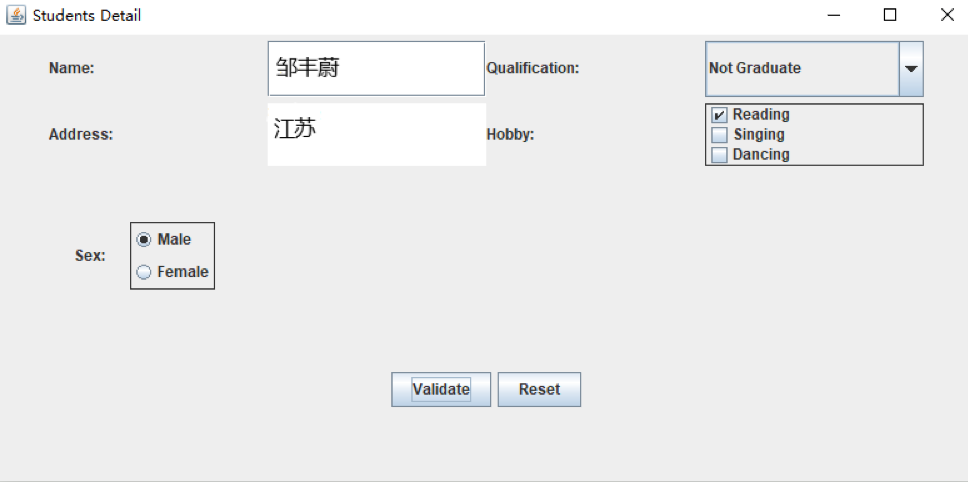
2.建立兩個執行緒,每個執行緒按順序輸出5次“你好”,每個“你好”要標明來自哪個執行緒及其順序號。
package demo; class Lefthand extends Thread { public void run() { for (int i = 1; i <= 5; i++) { System.out.println("左:"+i+" 你好!"); try { sleep(300); } catch (InterruptedException e) { System.out.println("Lefthand error."); } } } } class Righthand extends Thread{ public void run() { for (int i = 1; i <= 5; i++) { System.out.println("右:"+i+" 你好!"); try { sleep(300); } catch (InterruptedException e) { System.out.println("Righthand error."); } } } } public class ThreadTest { static Lefthand left; static Righthand right; public static void main(String[] args) { left = new Lefthand(); right = new Righthand(); left.start(); right.start(); } }
得出結果:

完善實驗十五 GUI綜合程式設計練習程式。
身份證:
package demo1; import java.awt.*; import javax.swing.*; public class ButtonTest { public static void main(String[] args) { EventQueue.invokeLater(() -> { JFrame frame = new Main(); frame.setTitle("身份證"); frame.setDefaultCloseOperation(JFrame.EXIT_ON_CLOSE); frame.setVisible(true); }); } }
package demo1; import java.io.BufferedReader; import java.io.File; import java.io.FileInputStream; import java.io.InputStreamReader; import java.io.FileNotFoundException; import java.io.IOException; import java.util.ArrayList; import java.util.Arrays; import java.util.Collections; import java.util.Scanner; import java.awt.*; import javax.swing.*; import java.awt.event.*; public class Main extends JFrame { private static ArrayList<Student> studentlist; private static ArrayList<Student> list; private JPanel panel; private JPanel buttonPanel; private static final int DEFAULT_WITH = 600; private static final int DEFAULT_HEIGHT = 300; public Main() { studentlist = new ArrayList<>(); Scanner scanner = new Scanner(System.in); File file = new File("C:\\Users\\ASUS\\Desktop\\身份證號.txt"); try { FileInputStream fis = new FileInputStream(file); BufferedReader in = new BufferedReader(new InputStreamReader(fis)); String temp = null; while ((temp = in.readLine()) != null) { Scanner linescanner = new Scanner(temp); linescanner.useDelimiter(" "); String name = linescanner.next(); String number = linescanner.next(); String sex = linescanner.next(); String age = linescanner.next(); String province = linescanner.nextLine(); Student student = new Student(); student.setName(name); student.setnumber(number); student.setsex(sex); int a = Integer.parseInt(age); student.setage(a); student.setprovince(province); studentlist.add(student); } } catch (FileNotFoundException e) { System.out.println("學生資訊檔案找不到"); e.printStackTrace(); } catch (IOException e) { System.out.println("學生資訊檔案讀取錯誤"); e.printStackTrace(); } panel = new JPanel(); panel.setLayout(new BorderLayout()); JTextArea jt = new JTextArea(); panel.add(jt); add(panel, BorderLayout.NORTH); buttonPanel = new JPanel(); buttonPanel.setLayout(new GridLayout(1, 7)); JButton jButton = new JButton("名單"); JButton jButton1 = new JButton("年齡"); JLabel lab = new JLabel("省份"); JTextField jt1 = new JTextField(); JLabel lab1 = new JLabel("年齡:"); JTextField jt2 = new JTextField(); JLabel lab2 = new JLabel("輸入你的身份證號碼:"); JTextField jt3 = new JTextField(); JButton jButton2 = new JButton("退出"); jButton.setBounds(110, 90, 60, 30); jButton1.setBounds(110, 90, 60, 30); jt1.setBounds(110, 90, 60, 30); jt2.setBounds(110, 90, 60, 30); jt3.setBounds(110, 90, 60, 30); jButton2.setBounds(110, 90, 60, 30); jButton.addActionListener(new ActionListener() { public void actionPerformed(ActionEvent e) { Collections.sort(studentlist); jt.setText(studentlist.toString()); } }); jButton1.addActionListener(new ActionListener() { public void actionPerformed(ActionEvent e) { int max = 0, min = 100; int j, k1 = 0, k2 = 0; for (int i = 1; i < studentlist.size(); i++) { j = studentlist.get(i).getage(); if (j > max) { max = j; k1 = i; } if (j < min) { min = j; k2 = i; } } jt.setText("年齡最大:" + studentlist.get(k1) + "年齡最小:" + studentlist.get(k2)); } }); jButton2.addActionListener(new ActionListener() { public void actionPerformed(ActionEvent e) { dispose(); System.exit(0); } }); jt1.addActionListener(new ActionListener() { public void actionPerformed(ActionEvent e) { String find = jt1.getText(); String text = ""; String place = find.substring(0, 3); for (int i = 0; i < studentlist.size(); i++) { if (studentlist.get(i).getprovince().substring(1, 4).equals(place)) { text += "\n" + studentlist.get(i); jt.setText("老鄉:" + text); } } } }); jt2.addActionListener(new ActionListener() { public void actionPerformed(ActionEvent e) { String yourage = jt2.getText(); int a = Integer.parseInt(yourage); int near = agenear(a); int value = a - studentlist.get(near).getage(); jt.setText("年齡相近:" + studentlist.get(near)); } }); jt3.addKeyListener(new KeyAdapter() { public void keyTyped(KeyEvent e) { list = new ArrayList<>(); Collections.sort(studentlist); String key = jt3.getText(); for (int i = 1; i < studentlist.size(); i++) { if (studentlist.get(i).getnumber().contains(key)) { list.add(studentlist.get(i)); jt.setText(“\n" + list); } } } }); buttonPanel.add(jButton); buttonPanel.add(jButton1); buttonPanel.add(lab); buttonPanel.add(jt1); buttonPanel.add(lab1); buttonPanel.add(jt2); buttonPanel.add(lab2); buttonPanel.add(jt3); buttonPanel.add(jButton2); add(buttonPanel, BorderLayout.SOUTH); setSize(DEFAULT_WITH, DEFAULT_HEIGHT); } public static int agenear(int age) { int min = 53, value = 0, k = 0; for (int i = 0; i < studentlist.size(); i++) { value = studentlist.get(i).getage() - age; if (value < 0) value = -value; if (value < min) { min = value; k = i; } } return k; } }
package demo1; public class Student implements Comparable<Student> { private String name; private String number ; private String sex ; private int age; private String province; public String getName() { return name; } public void setName(String name) { this.name = name; } public String getnumber() { return number; } public void setnumber(String number) { this.number = number; } public String getsex() { return sex ; } public void setsex(String sex ) { this.sex =sex ; } public int getage() { return age; } public void setage(int age) { // int a = Integer.parseInt(age); this.age= age; } public String getprovince() { return province; } public void setprovince(String province) { this.province=province ; } public int compareTo(Student o) { return this.name.compareTo(o.getName()); } public String toString() { return name+"\t"+sex+"\t"+age+"\t"+number+"\t"+province+"\n"; } }
計算器:
package T; import java.awt.Font; import java.awt.event.ActionEvent; import java.awt.event.ActionListener; import java.io.FileNotFoundException; import java.io.PrintWriter; import java.util.Collections; import java.util.Scanner; import javax.swing.*; import java.math.*; public class D extends JFrame { private String[] c=new String[10]; private String[] c1=new String[11]; private int[] list=new int[10]; int i=0,i1=0,sum = 0; private PrintWriter out = null; private JTextArea text,text1; private int counter; public D() { JPanel Panel = new JPanel();Panel.setLayout(null); JLabel JLabel1=new JLabel("...");JLabel1.setBounds(500, 800, 400, 30);JLabel1.setFont(new Font("Courier",Font.PLAIN,35)); JButton Button = new JButton("生成題目");Button.setBounds(50,150,150,50);Button.setFont(new Font("Courier",Font.PLAIN,20)); Button.addActionListener(new Action()); JButton Button2 = new JButton("確定答案");Button2.setBounds(300,150,150,50);Button2.setFont(new Font("Courier",Font.PLAIN,20));Button2.addActionListener(new Action1()); JButton Button3 = new JButton("讀出檔案");Button3.setBounds(500,150,150,50);Button3.setFont(new Font("Courier",Font.PLAIN,20));Button3.addActionListener(new Action2()); text=new JTextArea(30,80);text.setBounds(30, 50, 200, 50);text.setFont(new Font("Courier",Font.PLAIN,35)); text1=new JTextArea(30,80);text1.setBounds(270, 50, 200, 50);text1.setFont(new Font("Courier",Font.PLAIN,35)); Panel.add(text); Panel.add(text1); Panel.add(Button); Panel.add(Button2); Panel.add(Button3); Panel.add(JLabel1); add(Panel); } private class Action implements ActionListener { public void actionPerformed(ActionEvent event) { text1.setText("0"); if(i<11) { int a = 1+(int)(Math.random() * 99); int b = 1+(int)(Math.random() * 99); int m= (int) Math.round(Math.random() * 3); switch(m) { case 1: while(a<b){ b = (int) Math.round(Math.random() * 100);a = (int) Math.round(Math.random() * 100); } c[i]=((i+1)+":"+a+"/"+b+"="); list[(i+1)]=Math.floorDiv(a, b); text.setText((i+1)+":"+a+"/"+b+"="); i++; break; case 2: c[i]=((i+1)+":"+a+"*"+b+"="); list[(i+1)]=Math.multiplyExact(a, b); text.setText((i+1)+":"+a+"*"+b+"="); i++; break; case 3: c[i]=((i+1)+":"+a+"+"+b+"="); list[(i+1)]=Math.addExact(a, b); text.setText((i+1)+":"+a+"+"+b+"="); i++; break ; case 4: while(a<=b){ b = (int) Math.round(Math.random() * 100);a = (int) Math.round(Math.random() * 100); } c[i]=((i+1)+":"+a+"-"+b+"="); text.setText((i+1)+":"+a+"-"+b+"="); list[(i+1)]=Math.subtractExact(a, b); i++; break ; } } } } private class Action1 implements ActionListener { public void actionPerformed(ActionEvent event) { if(i<10) { String daan=text1.getText().toString().trim(); int a = Integer.parseInt(daan); if(text1.getText()!=" ") { if(list[i1]==a) sum+=10; } c1[i1]=daan; i1++; } } } private class Action2 implements ActionListener { public void actionPerformed(ActionEvent event) { try { out = new PrintWriter("text.txt"); } catch (FileNotFoundException e) { e.printStackTrace(); } for(int counter=0;counter<10;counter++) { out.println(c[counter]+c1[counter]); } out.println("成績"+sum); out.close(); } } }
package T; import java.awt.Dimension; import java.awt.EventQueue; import java.awt.Toolkit; import javax.swing.JFrame; public class N { public static void main (String args[]) { Toolkit t=Toolkit.getDefaultToolkit(); Dimension s=t.getScreenSize(); EventQueue.invokeLater(() -> { JFrame frame = new D(); frame.setBounds(0, 0,(int)s.getWidth()/2,(int)s.getHeight()/2); frame.setTitle(" "); frame.setDefaultCloseOperation(JFrame.EXIT_ON_CLOSE); frame.setVisible(true); }); } }
實驗總結:
多執行緒的概念:
多執行緒是程序執行過程中產生的多條執行線索。
‐執行緒是比程序執行更小的單位。
執行緒不能獨立存在,必須存在於程序中,同一進
程的各執行緒間共享程序空間的資料。
‐每個執行緒有它自身的產生、存在和消亡的過程,
是一個動態的概念。
多執行緒意味著一個程式的多行語句可以看上去幾
乎在同一時間內同時執行。
‐執行緒建立、銷燬和切換的負荷遠小於程序,又稱
為輕量級程序(lightweight process)。
用Thread類的子類建立執行緒:
⚫首先需從Thread類派生出一個子類,在該子類中
重寫run()方法。
⚫ 然後用建立該子類的物件
⚫ 最後用start()方法啟動執行緒
用Thread類的子類建立多執行緒的關鍵性操作:
–定義Thread類的子類並實現使用者執行緒操作,即
run()方法的實現。
–在適當的時候啟動執行緒。
由於Java只支援單重繼承,用這種方法定義的類不
可再繼承其他父類。
用Runnable()介面實現執行緒:
⚫ 首先設計一個實現Runnable介面的類;
⚫ 然後在類中根據需要重寫run方法;
⚫ 再建立該類物件,以此物件為引數建立Thread
類的物件;
⚫ 呼叫Thread類物件的start方法啟動執行緒,將
CPU執行權轉交到run方法。
執行緒兩種建立方法比較:
實現Runnable介面的優勢:
•符合OO設計的思想
•便於用extends繼承其它類
✓ 採用繼承Thread類方法的優點:程式碼簡單
✓ 提倡採用第一種方式
通過本週理論知識的學習以及在實驗課上所做的實驗,我掌握了執行緒的概念,也懂得了如何去理論執行緒的知識點在頁面佈局管理器上編輯一些東西。
